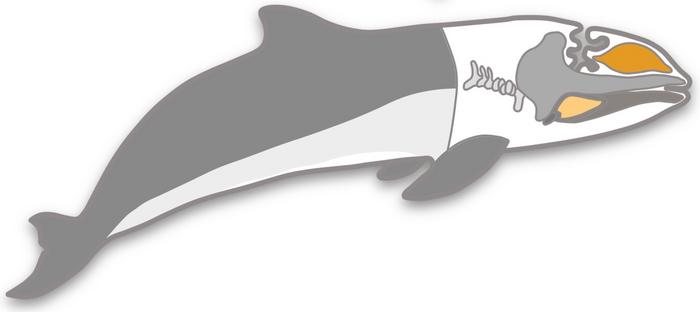Toothed whales traded chewing for echolocation to evolve
Dolphins and other toothed whales–or Odontocetes–use their heads to create sounds that help them communicate, navigate, and hunt in their murky marine world. These sometimes vocal-fry-like sounds reveal information about their murky marine world that is critical for survival. Some new genetic analysis suggests that the collections of fatty tissues that enable echolocation in toothed whales may have evolved from their skull muscles and bone marrow,changing how these animals eat and sense the world around them. The findings are described in a study published in the April 2024 issue of the journal Gene.
Toothed whales include numerous dolphin species as well as orcas, sperm whales, belugas, and narwhals. Echolocation produced by a bulbous mass of fat tissue inside of their heads called the melon.
Alongside of the jawbone of dolphins and toothed whales is a group of sound producing extramandibular fat bodies (EMFB). Another set of acoustic fat deposits called the intramandibular fat bodies (IMFB) are located inside the jawbone. The evolution of the melon, the extramandibular, and intramandibular fat bodies was critical for echolocation to develop in these marine mammals. However, little is known about how these fatty tissues themselves originated genetically.

“Toothed whales have undergone significant degenerations and adaptations to their aquatic lifestyle,” Hayate Takeuchi, a study co-author and PhD student at Hokkaido University in Japan, said in a statement.
One of these adaptations was the partial loss of their sense of smell and taste, alongside the gain of echolocation. To look closer at this and other adaptations at a genetic level, the team from Hokkaido University studied DNA sequences of genes that are expressed in these acoustic fat bodies. They measured the gene expressions in harbor porpoises (Phocoena phocoena) and Pacific white-sided dolphins (Lagenorhynchus obliquidens).
[Related: This dolphin ancestor looked like a cross between Flipper and Moby Dick.]
They found that the genes which are normally associated with muscle function and development were active in the melon and EMFB’s on the outside of the jawbone. There was also evidence of an evolutionary connection between this fat and a muscle called the masseter muscle. In humans, the masseter muscle connects the lower jawbone to the cheekbones and is one of the the key muscles used in chewing.
“This study has revealed that the evolutionary tradeoff of masticatory muscles for the EMFB—between auditory and feeding ecology—was crucial in the aquatic adaptation of toothed whales,” study co-author and genome scientist and evolutionary biologist Takashi Hayakawa said in a statement. “It was part of the evolutionary shift away from chewing to simply swallowing food, which meant the chewing muscles were no longer needed.”
[Related: We finally know how baleen whales make noise.]
When the team analyzed the gene expression in the intramandibular fat on the inside of the jawbone, they found active genes related to some elements of immune response and regulation of a group of white blood cells that fight infection called T cells. The team believes that this is due to its proximity to bone marrow–which helps produce T cells–and requires more study.
The team also credited the Stranding Network Hokkaido as another important aspect of the research, as the samples used in this study were collected by them. The organization has collected specimens of stranded whales along the seashore and river mouth in Hokkaido. Performing necropsies on stranded marine mammals have been critical for sampling and research to learn more about the potential causes of strandings and death, but also anatomy, physiology, and evolution.
(责任编辑:产品中心)
- ·Yes, big spiders are spreading in the U.S. No, they're not flying.
- ·Ronaldo staying despite starting season opener on bench, say Juve
- ·S. Korea has 4th highest smartphone penetration: data
- ·Australia's High Court website crashes minutes before marriage equality postal vote decision
- ·Smiley face on Mars is a telltale sign of its past
- ·7 in 10 workers in favor of ‘peak wage’ system
- ·Barty powers past Kerber into WTA Cincinnati final
- ·Here's how Facebook and GIPHY became friends again
- ·World’s first ‘meltdown
- ·Ronaldo is staying at Juve, says Allegri
- ·Pope says England are not 'one
- ·NK leader calls S. Korea 'primary foe,' vows to protect country with power
- ·PL clubs won't release players for red
- ·Ronaldo tipped to leave Juventus for Manchester City
- ·蒙顶山茶有了专属茶器
- ·Sweden's ambassador
- ·Google's massive Street View camera backpack is heavy AF
- ·Experts say concerns about new North Korea
- ·We Bought the Cheapest DDR5 RAM Modules We Could Find, Are They Any Good?
- ·加强工伤预防 护航安全生产












![[Newsmaker] Objectors challenge conscription law](http://res.heraldm.com/content/image/2015/07/09/20150709001486_0.jpg)